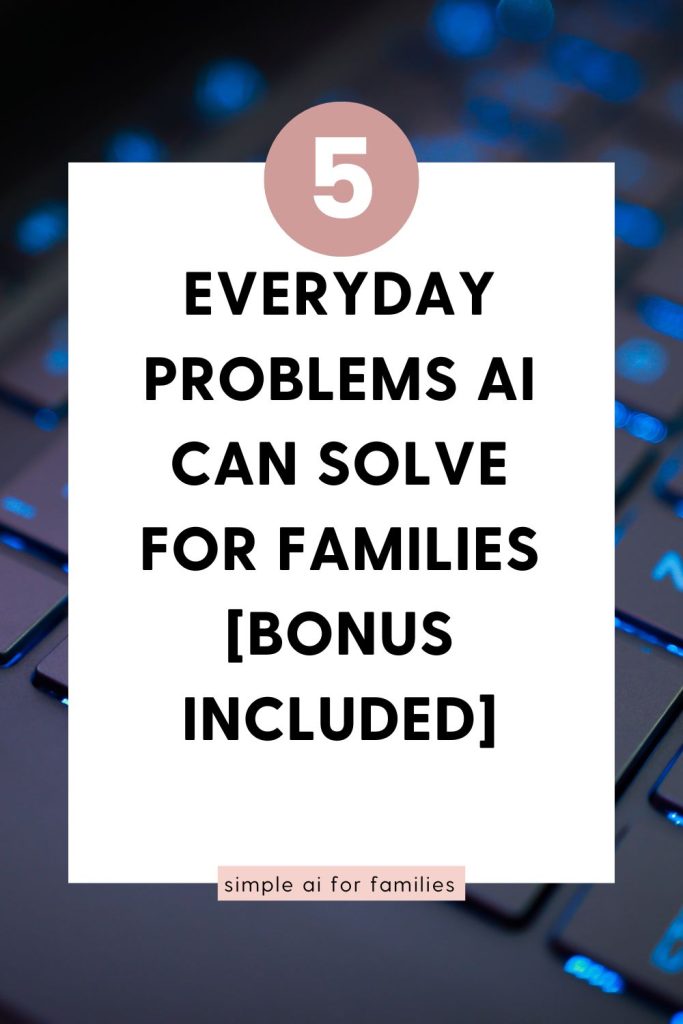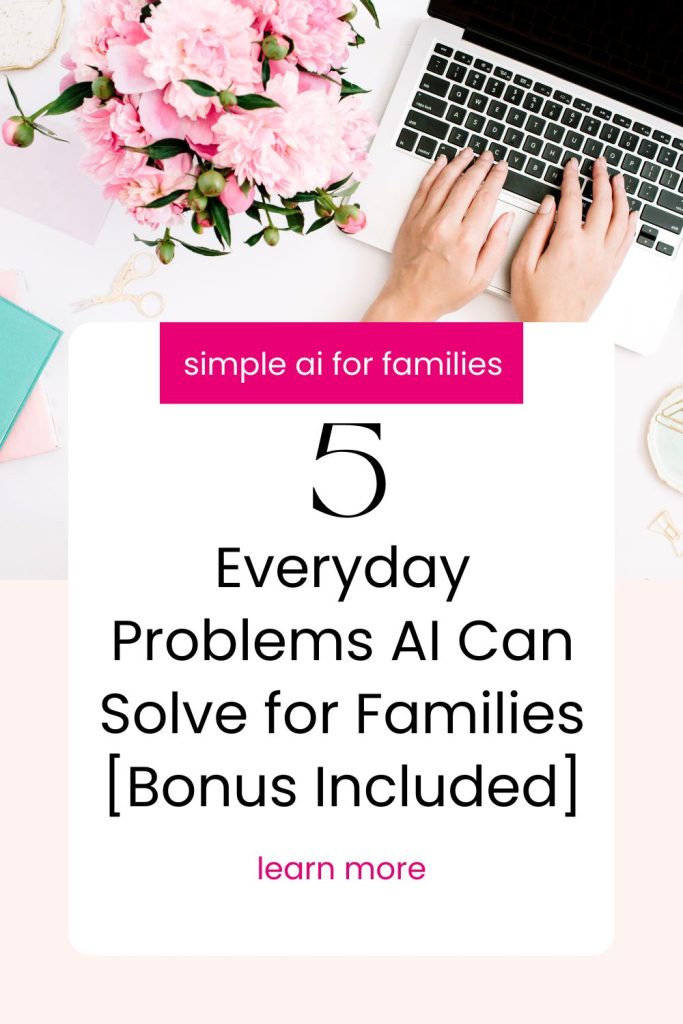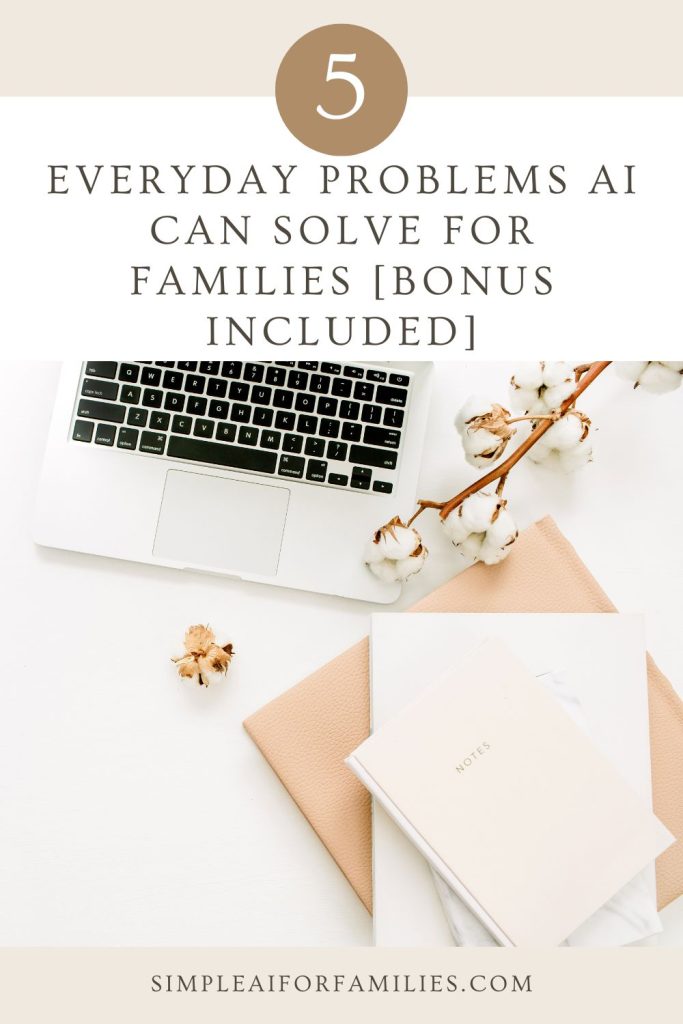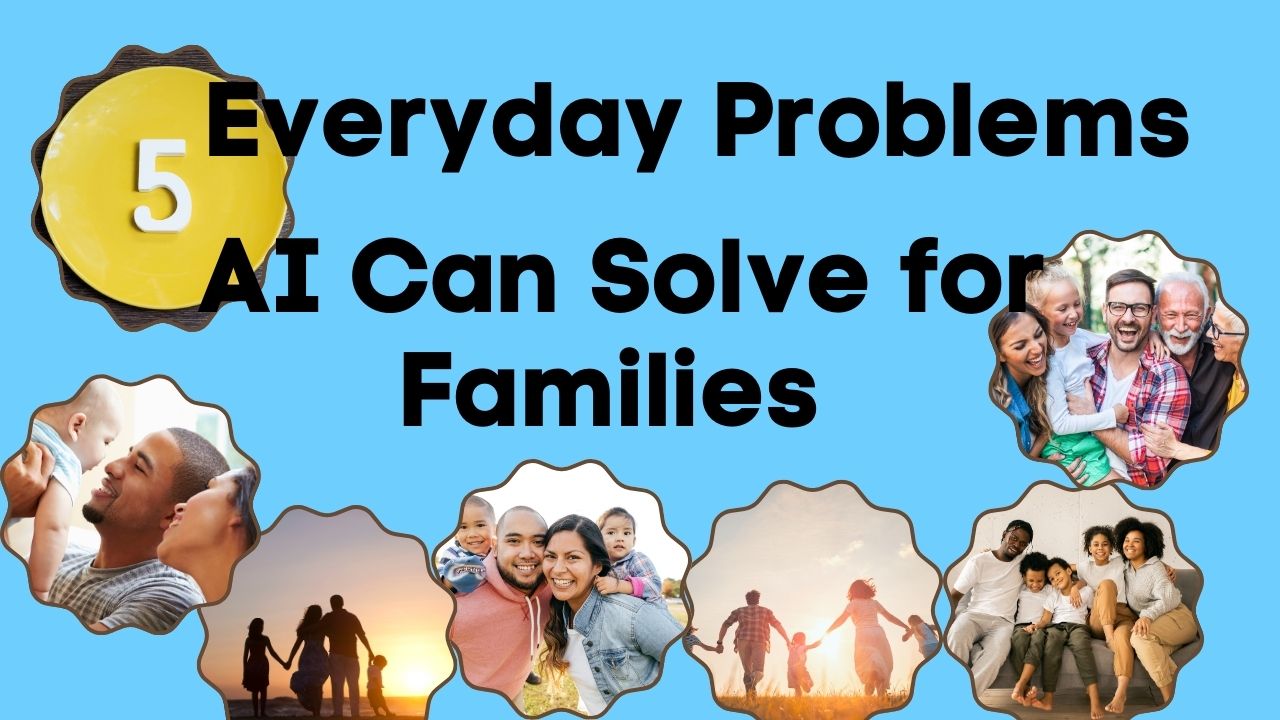How AI Can Solve Everyday Problems for Busy Families
Parenting while juggling work, homeschooling, and a million daily tasks isn’t easy — and if you’re anything like me, it can feel impossible to keep up. Between meal planning, chore assignments, and endless shopping lists, I needed real help. That’s when I discovered how AI tools could step in and solve everyday problems for my busy family. In this post, I’m sharing the real ways AI has made our life smoother — and how it can do the same for you.
AI is already working behind the scenes to make family life smoother—even if you haven’t noticed. From juggling busy schedules to helping kids with homework, artificial intelligence can handle common struggles that every household faces. As someone just starting out with AI, you don’t need fancy tech skills to see real benefits.
Common Family Problems AI Can Help Solve
In this post, I’ll show simple ways AI can solve problems families deal with daily, making routines less stressful and more fun. You’ll learn clear, practical tips so you can use these tools with confidence. Plus, I’ve included a special bonus to give your family an extra boost. If you want a quick introduction to artificial intelligence before diving in, check out the Beginner’s guide to AI for easy steps and family-friendly advice.
Organizing Family Schedules with AI
Trying to keep up with school, sports, work, and everyone’s appointments is enough to make your head spin. I know what it’s like to juggle calendars, text reminders, and sticky notes—only to forget something anyway. AI now brings order to this chaos, giving families simple yet powerful tools to sync everyone up and make sure nothing falls through the cracks.

Photo by Jessica Lewis 🦋 thepaintedsquare
AI-Powered Family Calendars
With an AI-powered family calendar, everyone’s appointments, school events, and special days can live in one place. These tools automatically scan emails for invites, find conflicts, and suggest the best times for family events. I love how these systems share real-time updates, so if soccer practice moves or a school meeting pops up, everyone’s in the loop.
Some of the biggest problems AI can solve for families include:
- Sending smart reminders (so you never miss pickup)
- Notifying when schedules change
- Tracking recurring events and birthdays
- Syncing with existing apps, like Google or Apple Calendar
If you want to learn how a centralized touchscreen can make sharing the family calendar almost automatic, take a look at the features in the Skylight. It’s my favorite and the one we use. Although ours wasn’t $600 because it wasn’t the biggest one on the market.
Managing Conflicts and Setting Priorities
AI doesn’t just manage dates—it can spot double bookings and help set priorities. If two activities overlap, AI will suggest who should attend which event, or recommend the best time to reschedule. These assistants can also rank activities based on family rules, so you don’t have to debate which event takes priority.
A few features that make this possible:
- Automatic conflict detection
- Priority-based recommendations
- Easy rescheduling tools
- Alerts for important or last-minute changes
You can check out a roundup of the best AI scheduling assistants to see what features might fit your family’s needs.
Keeping Everyone on the Same Page
No more repeating yourself about dinner plans or practice times—AI keeps all family members synced. Notifications go straight to everyone’s device. Some apps even use voice commands or color-coded calendars so younger kids can stay involved. It also helps share responsibility, as everyone can check or update plans on their own.
We have my daughter’s calendar synced with ours and we’re able to see when we can plan family activities based on her availability and my other boys.
When everyone knows where they need to be and when, there’s less stress and fewer arguments. AI makes keeping track of family commitments less of a full-time job.
For more family tech tips, see how I simplify chores with smart helpers in my guide to using AI in everyday family routines.
Bonus: Smart List and To-Do Generators
Here’s a trick I use that’s saved me hours: list-making AI tools. They build grocery lists from meal plans, set reminders for school supplies, and even plan out holiday shopping. All I have to do is check things off as I go. Try linking your family calendar with one of these smart list apps and watch the clutter disappear.
Streamlining Meal Planning and Grocery Shopping
As a parent, planning meals for the week used to feel like a puzzle with missing pieces. Deciding what to cook, making a list, and then remembering everything at the store—it was always a hassle. Now, smarter AI tools step in to reduce stress and save hours. If you’re just learning how problems AI can solve for families, meal planning and grocery shopping is one of the easiest places to start seeing results.


Photo by Greta Hoffman
Personalized Meal Planning with AI
AI-powered meal planners make family dinners much less of a guessing game. I no longer have to scroll endlessly for recipes or worry about missing ingredients. Apps can now remember our family’s food preferences, diet needs, and even favorite cuisines.
With just a few taps, these planners suggest recipes, create balanced menus, and adjust serving sizes—saving time and cutting food waste. This is a big help for allergy-friendly homes or picky eaters, too.
Features that make AI meal planners stand out:
- Weekly menu suggestions based on what’s in your fridge
- Nutrition tracking for healthy eating goals
- Instant recipe adjustments for more guests or leftovers
Grocery List Automation
Gone are the days of standing in the aisles, wondering what you forgot. AI syncing between meal planners and grocery apps makes the process nearly automatic. After you select your weekly meals, your phone can instantly build a grocery list for you, sorted by store sections. Need to remember to buy snacks or diapers? Just add them with a voice command.
Some apps even let each family member add to the list in real-time. So if your partner says you’re out of milk, it gets added before they forget. Tools like AnyList are designed for busy families and make sharing lists simple.
Key benefits of grocery list automation:
- Fewer forgotten items at the store
- Less time spent writing and rewriting lists
- Shared access, so everyone’s needs get included
- Organized lists by category or aisle for quicker shopping
Saving Money and Reducing Food Waste
AI doesn’t only save time—it saves money, too. Meal planning apps track pantry inventory and suggest meals with what you already have. This helps avoid duplicate buys and keeps food from spoiling at the back of the fridge. Some tools alert you to sales or the cheapest options for your regular items, which is great for budget-conscious families.
A few practical perks:
- Automatic reminders to use produce before it spoils
- Suggestions for recipes using leftovers or on-sale items
- Lower food bills from smarter shopping and less waste
If food budgeting is a priority, check out resources like easy family meals on a budget for more savings inspiration.
Bonus: Smart Pantry and Recipe Sync
Here’s a feature I love—many apps now link your pantry, recipes, and shopping lists together. Scan your groceries with your phone, and the app updates what you have at home. When you run low on staples, they’re added to your next shopping list automatically. No more last-minute runs for forgotten pasta or cereal.
If you want more tips on using AI for daily home routines (and making chores less of a headache), check out my guide to family routine automation with AI.
AI takes the endless cycle of meal planning and grocery shopping and turns it into a routine you barely have to think about. The more you use these tools, the more they’ll fit your family’s unique needs—leaving more time for everything else.
Personalized Learning Support for Kids
Personalized learning is one of the core problems AI can solve for families—especially when it comes to helping kids stay on track. Every child learns at a unique pace, and one-size-fits-all solutions just don’t cut it. AI-powered tools now act like private tutors, giving children the right guidance, homework help, and interactive activities suited to their interests and abilities.

Photo by Ivan Samkov
AI Tutors Tailored to Each Child
Adaptive tutoring apps now understand where a child struggles and where they excel. Instead of generic worksheets, these apps generate lessons or practice questions designed for the exact spot your child needs help. If they breeze through math but stall on reading, the AI focuses a little more on reading skills—never making them backtrack unnecessarily.
This tailored approach keeps learning fun and frustration low. Kids feel encouraged as the AI gives instant feedback, gentle hints, or extra challenges when they’re ready. As a parent, you can track progress through easy-to-read dashboards.
Helping with Homework and Projects
When the nightly homework struggle hits, AI tools step in to answer questions, walk through tricky math problems, or offer step-by-step explanations. This isn’t about shortcuts or cheating—it’s about guiding kids to build confidence and strengthen skills. Some apps even let you scan a worksheet and get a personalized learning path instantly.
Many families use AI to create quiz games, help organize research for school projects, or translate new words for language homework. It makes after-school routines less stressful and lets everyone feel more supported.
Encouraging Creativity and Curiosity
AI isn’t just about homework—it can spark a child’s curiosity. There are creative writing apps, interactive math games, and drawing tools powered by AI. These platforms learn what kids love and suggest new topics or projects that match their style. For example, if your child starts writing stories about animals, the AI may suggest fun animal facts or drawing prompts.
A key benefit is that children can safely explore a wide range of interests at their own speed, helping them stay curious and engaged outside school.
Bonus: Personalized Reading and Learning Recommendations
Here’s my favorite hack for busy parents: many apps now recommend books, experiments, and videos that match your child’s current level and interests. These suggestions keep kids entertained and learning (even over school breaks). If you’re building a habit of reading together or want new activity ideas, this feature is a lifesaver.
For more ideas about how AI fits into family life and future job skills, I recommend reading about families working together to solve problems using AI.
If you want hands-on tips for encouraging children to use AI tools safely and productively, see my post on safe AI app usage for families. Personalized learning support shows how AI is a true helper, building skills and confidence with every interaction.
Improving Family Communication and Well-Being
Families face unique emotional challenges, from daily stress to big life changes. Problems AI can solve for families aren’t just about chores and schoolwork—AI is now making it easier to support each other’s mental well-being at home. Even if technology sometimes feels cold or impersonal, the right AI tools can create moments of warmth, understanding, and better communication. Let’s explore how these beginner-friendly apps and chatbots can help.

Photo by Artem Podrez
Many families deal with stress, anxiety, or mood swings at home. Sometimes, it’s hard for kids or parents to talk about these feelings—especially when everyone’s busy. Simple AI apps can now give families a safe space for emotional check-ins or a quick mood boost.
Here’s how AI is supporting family well-being:
- AI Chatbots for Stress and Anxiety: Apps like Wysa offer friendly, confidential chatbots that help both children and adults talk through tough emotions. You can message these bots when you’re feeling down or worried, and they reply with empathy and handy coping tips.
- Mood and Wellness Trackers: Tools like Moodfit use AI to track how you feel over time. They suggest healthy habits, simple breathing exercises, or ways to talk about stress before it builds up.
- Personalized Mental Health Support: Apps such as Youper guide users (including teens and parents) through evidence-based mental health exercises. These are easy to start, with clear steps for calming nerves or lifting mood.
Many of these tools are free or low-cost. Setup usually takes less than five minutes—perfect for busy families. Even a nightly mood check with your child can open new conversations and reduce misunderstandings between siblings or parents.
Important reminder: While these apps are helpful, privacy is always a big concern. Parents should always set up and monitor these tools for younger users. Make sure to review privacy settings and talk openly with your kids about what the apps do with their information. For practical guidance on keeping conversations safe, check out this guide on AI chatbots and children’s privacy.
AI can make emotional support more accessible, but it’s not a replacement for professional help when needed. For more tips on keeping your family safe and confident using technology, read my post on AI safety for families.
Bonus: Mindfulness and Family Meditation Prompts
One of my favorite features in some emotional wellness apps is built-in mindfulness reminders for the whole family. These AI-powered prompts suggest short guided meditations or family gratitude exercises—making it easy to pause, breathe, and reconnect after a hard day. Even five minutes together can make a big difference in everyone’s mood.
Try experimenting with a few family check-in questions, such as:
- What was the best part of your day?
- Did anything worry you today, even a little?
- Is there something you wish we could do together to feel better?
When families open up and support each other, everyone feels stronger. Problems AI can solve for families aren’t just about tech—the real transformation comes from building better habits and sharing more kindness, every single day.
Bonus: Enhancing Family Entertainment with AI
When it comes to making family time more exciting, AI brings fresh ways to laugh, play, and learn together—without a big tech setup. Many families think of AI as something for school or chores, but it can make movie nights, game time, and creative projects way more fun. Whether you want to spark imagination or keep everyone engaged after dinner, there’s something for all ages to enjoy.

Photo by Pavel Danilyuk
AI-Powered Games for the Whole Family
Many new apps use artificial intelligence to create trivia games that grow with your family’s interests. Some let you set up custom questions about family history or favorite things, and AI will shuffle them in. Others play guessing games, help with charades, or tell interactive stories where your choices shape what happens next.
Why choose AI-powered games?
- They keep everyone interested with changing questions or stories.
- You can mix learning (math, language, science) into play without anyone noticing.
- Kids stay engaged because the games adjust to their level in real time.
If you want a home-friendly, beginner option, try exploring printable activities or simple AI apps from the AI basics free guide. These don’t need special devices and work great for family nights.
Personalizing Movie, Music, and Book Recommendations
Problems AI can solve for families include picking what to watch or listen to—no more endless scrolling! AI is built into many streaming services, offering movie or show picks tailored to your family’s taste. The more you watch or listen, the better it gets at picking a winner for your next movie night.
How families use this feature:
- Get movie or show suggestions that fit everyone’s mood and interests.
- Build music playlists based on everyone’s favorite artists or genres.
- Find kid-friendly book picks or new bedtime stories, adjusted for age and reading level.
AI can even suggest new hobbies, podcasts, or games to try based on your current interests—so you’re never short on ideas for quality time.
Creating Together with AI Tools
If your family enjoys arts, crafts, or stories, AI can help spark even more creativity. Families are using free AI drawing apps, story generators, or music tools that turn your ideas into something completely new. Kids can help write a family story, and AI will fill in chapters with funny twists. Or, use a drawing prompt tool to see who can create the wildest picture in ten minutes.
Great ways to create with AI:
- Try voice assistants for interactive storytelling.
- Use a story generator to kick off bedtime tales.
- Experiment with music-making apps for family dance parties.
For even more family activities and ideas, jump into Getting started with AI, which offers print-friendly guides and project inspiration.
Bonus: Family Movie Night with AI Help
Here’s a fun bonus: some families now use AI assistants to plan themed movie nights. Just tell the AI your favorite actors or genres, get snack and recipe suggestions, and print out trivia cards based on your movie pick. In no time, you’ve turned a regular night into a special event everyone looks forward to.
If you’d like more everyday examples and first steps, the post on AI for moms offers more ways to use AI for smarter, happier family routines.
Families don’t need to be tech experts to enjoy these tools. With a little curiosity and some playful spirit, AI can make together time more memorable—one idea or laugh at a time. Problems AI can solve for families go far beyond chores and homework—they help us all connect.
Solving everyday challenges with practical AI tools leaves my family with more time to spend together and much less stress. I’ve seen firsthand how simple changes in routines add up to better mornings, easier meal times, and smoother homework sessions. Problems AI can solve for families aren’t just about chores—they create space for real moments and stronger bonds.
If you’re new to this, pick one tool from the list above and give it a try this week. Even small changes can make a visible difference right away. For more practical examples and advice on AI tools for family use, my guide at AI for parents is the perfect start.

Here’s a bonus: As you explore new ways to simplify daily life, ask your kids or partner what task they wish could be easier. Make it a family experiment. You might be surprised by how much you gain with just a little curiosity.
Share On Pinterest!










